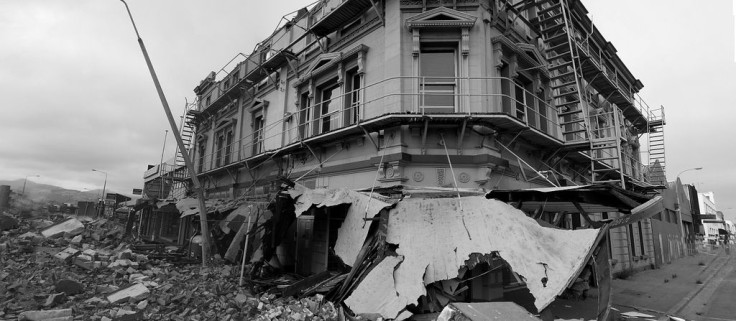Smartphones May Have The Potential Both To Detect Earthquakes And Send Warnings

Each day, we are discovering new uses for smartphones that go beyond social media interaction and selfie-taking. As researchers continue to tap into the hidden potential of our favorite little devices, they are finding that smartphones may be used to predict events as volatile as earthquakes. That’s right, you may be carrying around a mini seismograph in your pocket, and you didn’t even know it.
Researchers at the U.S. Geological Survey believe that smartphones, among many other popular electronic devices, could help detect earlier the presence of an earthquake in regions of the world that cannot afford early earthquake warning systems, but frequently use these devices. Not only could this technology help those lacking scientific instruments, it could also be used to spread the news of an earthquake across a region before it happens, allowing more people to prepare.
The study published in the AAAS journal Science Advances found that smartphones and similar devices have sensors that could be utilized for earthquake warning systems. Even though these sensors are not as accurate as scientific-grade equipment, the GPS receivers within a smartphone give these devices the potential to detect the permanent ground movement (displacement) that occurs during the large fault motion of an earthquake.
This proves to be quite the advancement, as earthquakes in themselves are very difficult to predict, allotting less time between notification and the actual occurrence than most other natural disasters. Scientists often predict earthquakes by monitoring movements of well-known fault zones; however, most prediction comes from probability and guessing. By looking at the history of earthquakes in a region, and examining pressure buildups, scientists can gauge the likelihood of an earthquake, but that’s about as good as it gets.
As a result, any form of early detection is key, and those located in earthquake-prone regions must have ways to spread the news as quickly as possible. Researchers plan to use “crowd-sourced observations” from the smartphones of participating users in order to detect, analyze, and customize earthquake warnings that can be sent back to these users. “Crowd-sourced alerting means that the community will benefit by data generated from the community,” said Sarah Minson, a USGS geophysicist, in a press release.
Crowd-sourced alerting may be able to act as earthquake early warning systems in areas that do not have this type of technology. As EEWs are used to detect the start of an earthquake and transmit the warning to those living within the area, not having this system in place puts those at a high risk of experiencing an earthquake at a serious disadvantage. “Most of the world does not receive earthquake warnings mainly due to the cost of building the necessary scientific monitoring networks,” said USGS geophysicist Benjamin Brooks. Yet a high percentage of the world’s population is susceptible to the devastation of large earthquakes.
In order to test the success of crowd-sourced EEW, researchers simulated a hypothetical magnitude 7 earthquake based on the example of the 2011 magnitude 9 earthquake in Tohoku-oki, Japan. Researchers found that crowd-sourced EEW could be possible with only a small percentage of participants in a given area contributing information from their smartphones. To put this into perspective, if fewer than 5,000 people in a large, highly populated area responded, the earthquake may be detected fast enough to transmit warnings to areas farther away before more violent shaking begins. “The speed of electronic warning travels faster than the earthquake shaking does,” said Craig Glennie, professor at the University of Houston.
This technology is limited, however. Scientists found that sensors in smartphones could only detect earthquakes of a magnitude of 7 or higher, but not smaller and potentially damaging earthquakes. “Crowd-sourced data are less precise, but for larger earthquakes that cause large shifts in the ground surface, they contain enough information to detect that an earthquake has occurred, information necessary to early warning,” said Susan Owen of NASA’s Jet Propulsion Laboratory in Pasadena, Calif. As a result, smartphones cannot be used to replace more scientific instruments when this type of equipment is available.
Researchers have also found that smartphones and other devices may help continue to improve scientific systems already in place. “The use of mobile phone fleets as a distributed sensor network — and the statistical insight that many imprecise instruments can contribute to the creation of more precise instruments — has broad applicability, including great potential to benefit communities where there isn’t an existing network of scientific instruments,” said Bob Iannucci of Carnegie Mellon University. Thomas Heaton, professor of Engineering Seismology at Caltech, also notes that this new technology provides almost instantaneous pictures of earthquake deformations with greater resolution than in the past.
This research also shows promise for future application. The U.S. Agency for International Development has agreed to fund a pilot project and has collaborated with the Chilean Centro Sismologico Nacional to test a pilot hybrid EEW consisting of both smartphone sensor technology and scientific-grade equipment on the Chilean coast.
Despite its drawbacks, smartphone technology may be the future of earthquake detection, allowing many to prepare for potential impact with greater rapidity and frequency.
Sources: Brooks B, Minson S, Glennie C, et al. Crowdsourcing Early Warnings of Natural Disasters. Science Advances. 2015.



























